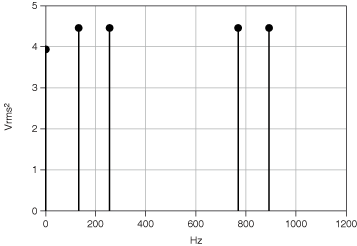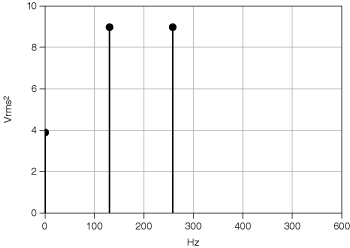Most frequency analysis instruments display only the positive half of the frequency spectrum because the spectrum of a real-world signal is symmetrical around DC. Thus, the negative frequency information is redundant. The two-sided results from the analysis functions include the positive half of the spectrum followed by the negative half of the spectrum, as shown in the previous front panel.
A two-sided power spectrum displays half the energy at the positive frequency and half the energy at the negative frequency. Therefore, to convert a two-sided spectrum to a single-sided spectrum, you discard the second half of the array and multiply every point except for DC by two, as shown in the following equations.


where SAA(i) is the two-sided power spectrum, GAA(i) is the single-sided power spectrum, and N is the length of the two-sided power spectrum. You discard the remainder of the two-sided power spectrum SAA, N/2 through N - 1.
The non-DC values in the single-sided spectrum have a height given by the following relationship:

The previous equation is equivalent to the following relationship.

where  is the root mean square (rms) amplitude of the sinusoidal component at frequency k.
is the root mean square (rms) amplitude of the sinusoidal component at frequency k.
The units of a power spectrum are often quantity squared rms, where quantity is the unit of the time-domain signal. For example, the single-sided power spectrum of a voltage waveform is in volts rms squared, Vrms2.
The following figures show the two-sided spectrum and single-sided spectrum of a time-domain signal, respectively.


The height of the non-DC frequency components in the single-sided spectrum is twice the height of the non-DC frequency component in the two-sided power spectrum. Also, the single-sided spectrum stops at half the frequency of that in the two-sided power spectrum.